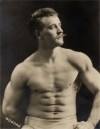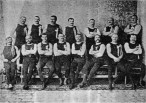Belgium
& Greco-Roman Wrestling |
Part 1 |
| When tiny Carl Schumacher of Berlin, already the world’s first Olympic gymnastic champion (he had won three gold medals) defeated the giant Scotsman, Launceston Elliot (1874/1930) in the first round of the 1896 Olympic Greco-Roman wrestling tournament, he proved not for the first or the last time that speed, agility, and science are more important in wrestling than mere ponderous strength. | ||
| Elliot a Scottish aristocrat (he was a nephew of the Earl of Minto) had just won the gold medal for weightlifting and has an honoured place in history as the first Olympic weightlifting champion but Schumacher the wrestling and gymnastic champion has been almost forgotten. When he and the other German ‘Turners’ returned home they were not greeted by cheering crowds, flags and riches, as would be the case today, but instead were banned from further competitions. (MacAloon) | ||
| Classical wrestling as Greco-Roman is often called owes nothing to the ancient Greeks or Romans, it is entirely French and was originally called, “les luttes à main plate” or “open handed wrestling.” Greco-Roman may be French in origin but Belgium was at the forefront of its modern development. The Olympic sport of Greco-Roman was born in Southern France in the early years of the 19th century, or more accurately, it was developed there from the traditional wrestling style still practised. What is certain is that the sport had reached its final and definitive form by 1848 but its gradual technical refinement in the gyms of Lyon and Bordeaux into the scientific modern Olympic style that we know today took many more years. | ||
| In the 1880s a New York policeman Bill Muldoon (1845/1933) claimed (in the USA) to be World Champion; he had learned Greco-Roman wrestling while serving as a mercenary in France during the Franco-Prussian war where he had sought further adventure after his experiences in the American Civil War. Muldoon was a very tough and honourable character but an early comparison with the modern US ‘World Series’ baseball tournaments is obvious because no one in Europe had heard of him. No tournaments were held in the USA in that period, only challenge matches on which large sums were gambled and anyone could claim to be a champion. In Europe contests were at first challenge matches held in circuses and fair grounds but regular matches began to be held in Paris in 1848 in “Les arenes de la rue Montesquieu.” (Lèon Ville, 1891) | ||
| The sport’s popularity rose and fell in Paris and promoters travelled around Europe with troupes of wrestlers challenging ‘all comers’. A. Fénélon of Bordeaux the famous wrestler, trainer and referee wrote in 1910 that in the early days male bulk and muscularity were more important to the public than mere technical skill. It was a phenomenon which has been described by some sports sociologists as ‘homo-eroticism’ caused by they claim, a reaction to the, “sedentary, egalitarian and homogenizing tendencies of modern society.” (Payne, History of Fascism) George Moses wrote in, ‘The Image of Man: The Creation of Modern Masculinity (Oxford 1966), “The enemies of modern, normative masculinity seemed everywhere on the attack: women trying to break out of their traditional role; “unmanly” men and “unwomanly” women…were becoming ever more visible. They and the movement for women’s rights threatened that gender division so crucial to the construction of masculinity.” | ||
| Whatever the truth of these fashionable modern academic speculations the phenomenon reached its peak with the Prussian wrestler turned strongman Eugen Sandow (1867/1925) who became ‘personal trainer’ to the British King, Edward VIII. He was appointed, “Professor of Scientific Physical Culture” in 1911 to Edward’s successor King George V. | ||
While these developments were gathering pace an enterprising Swiss/Italian wrestler turned promoter called Battaglia (born 1852 at Vira Gambarogno) organised a wrestling and strength tournament in Brussels, which he declared to be a ‘World Championship’. Prof. E. Desbonnet (1868/1953) wrote in Les Rois de la Lutte in 1910, “Ce fut seulement en 1897 qu’un championnat vint remettre en honneur ce sport ci interéssant.” (It was only in 1897 that a championship came to be held in honour of this so interesting sport.) |
||
| The tournament which was the first ever tournament claiming to be a championship in either Free style or Greco-Roman took place in the Cirque Royale De Bruxelles from 7th to the 18th August and attracted 118 competitors; Maurice Gambier of Bordeaux won the wrestling competition and Noël Rouveirolis of Sète (1864/1939) better known as Noël Le Gaulois (on account of his huge moustache) won the title of World’s Strongest Man. Albert de Laitte of Sprimont a respected Belgian historian of strength sports describes this tournament as a World Championship, which was also the opinion at the time of Professor Desbonnet of Lille. At this point in my brief account of the history of Greco-Roman the Belgian connection may seem so slight as to be almost frivolous but let me go back a few years. | ||
Prior to the ‘Golden Age’
of professional wrestling (1890/1914) Achille Mouchon (born Ghent
1855 died 1900) his baraque and troupe of wrestlers toured Belgium,
The Netherlands and France with moderate success but the glorious
days of wrestling in Belgium were still to come. Constant Lavaux
was born in in Florennes in the province of Namur in 1877; he was
a farmer’s son and worked in agriculture until he was 17 when
he took up the trade of butchering. At the age of 20 he journeyed
to Paris to practise his trade and in his leisure time he practised
wrestling wherever he could find a gym. Eventually he found the
gym of the great wrestler Paul Pons (1864/1915) and his professional
career began. I can find no record of where he learned to wrestle
but believe it to be in Florennes since his subsequent progress
was too rapid to have been possible for a beginner, no matter how
strong and gifted. |
||
| When Constant Lavaux arrived in Paris the wrestling craze, which was sweeping Europe and making Greco-Roman the main public spectacle in all the principle cities was about to reach its apogée. Constant le Boucher was about to become one of the most famous athletes in Europe if not the world and he would create a record, which cannot be repeated in the history of modern sport. | ||
| Théodore Vienne another very enterprising promoter and Director of the Vélodrome de Roubaix organised the first ever National Championship of France in a magnificent sport which France has gifted to the world and which should be recognised as its national sport; la lutte á mains platte, la lutte Francaise, la lutte Grecque, la lutte Romain, Classical wrestling, or, to use its modern name Greco-Roman style. | ||
| The championship final, which took place outdoors on 30th May 1898, was a hard fought bout but eventually the youth, vigour and stamina of the young Belgian, despite some very close shaves brought him victory over the veteran Félix Bernard (1857/1900) from Maubourget in the Hautes-Pyrénées. Constant Lavaux had become the first Champion of France in a sport presented to the world at large by one of Napoleon’s grognards (veterans). This sport, Greco-Roman, was developed by Jean Brayasse of Lyon from the more primitive wrestling style called in Provençal, ‘Lucho de la centuro en aut,’ (wrestling above the waist) which had been practised in Provençe since antiquity. | ||
| Continued on Belgium Traditional Wrestling & Greco-Roman Wrestling -PART 2 | ||
|
|
| © Copyright 2000 - 2009 Scottish
Wrestling Bond © Website Designed &
Maintained By: Davie McGinn |






